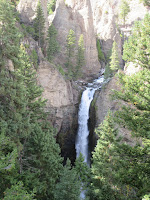
Along the park roads are broad, rolling valleys, grassy mountain meadows, and sagebrush covered flats where deer, elk, and bison roam along the winding rivers.


There are hills and mountains covered with trees: fir, aspen, spruce, and thick stands of lodgepole pine.
There are sparkling streams whose waters provide excellent environment for trout fishing.
And, there is Yellowstone Lake, the largest high elevation (above 7000 ft) lake in North America. Marinas, boating, camping and fishing opportunities are available there.
And, there is Yellowstone Lake, the largest high elevation (above 7000 ft) lake in North America. Marinas, boating, camping and fishing opportunities are available there.
Yellowstone is not only about the hydrothermal features. Yellowstone has something for everyone!
















